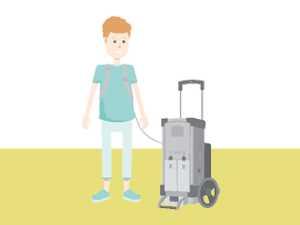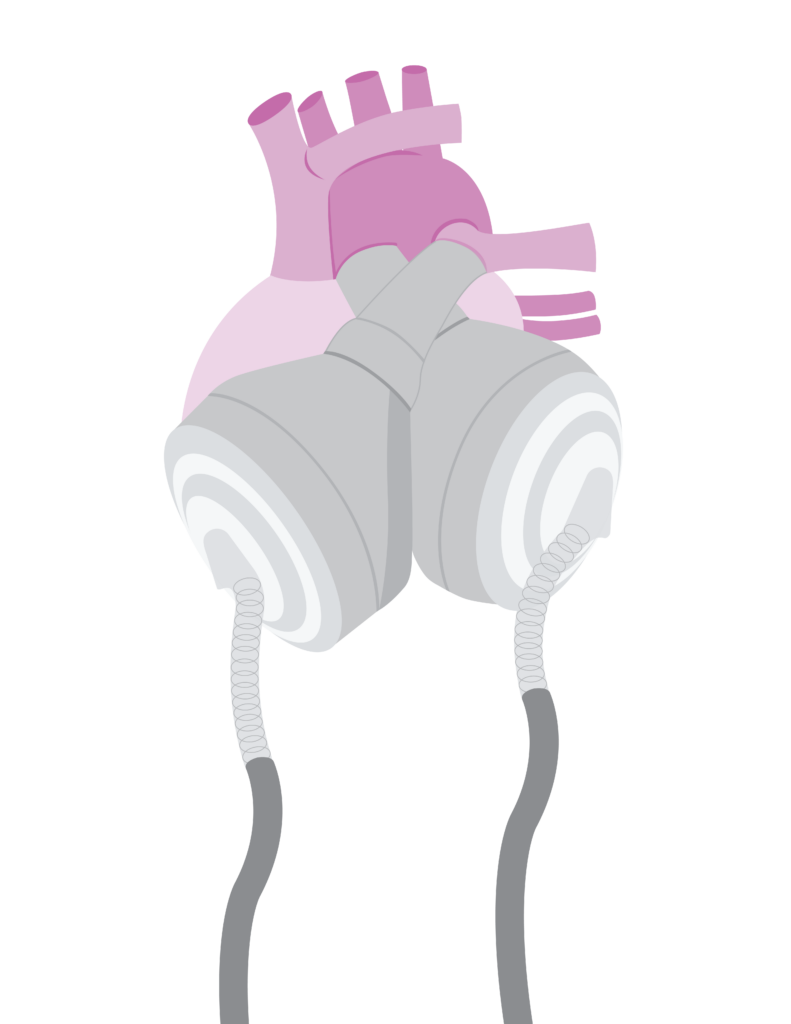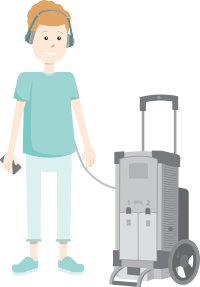
The SynCardia Total Artificial Heart (TAH-t) is different from the other VADs because it replaces the lower chambers of the heart (ventricles) and the four valves. The TAH-t pumps blood to both the lungs and body. Two tubes (cannulae) come out of the skin and connect to an external machine called a driver. The driver supplies pulses of air to pump blood in and out of the TAH-t. The TAH-t can fit in some larger children, teenagers, and adults. This device is most commonly used for patients who will get a heart transplant.
-
Device Components
-
Benefits
-
Risks
Device Components
There are several parts of the SynCardia TAH-t system.
SynCardia (TAH-t) Ventricles
The TAH-t pump replaces the sick or weak heart ventricles. The TAH-t pump has two chambers—an air chamber and a blood chamber—that are separated by a membrane. The air chamber connects to the cannula and driver, which pushes air in and out. The air moves the membrane in the correct position to fill and eject the blood chamber. On the blood chamber side, the blood enters and exits the chamber.
There are two different TAH-t pump sizes: 50 cc and 70 cc. The 50 cc pump is generally used in children and small adults. The 70 cc pump is used in bigger people. Prior to surgery, the care team will review your testing to determine which size device is appropriate for your body size.
Cannulae
The two cannulae come out of the body above the belly and connect the right and left TAH-t pumps to the Companion 2 Hospital Driver (C2).
Companion 2 (C2) Driver (Hospital Cart & Caddy) or Freedom® Portable Driver (Freedom Driver)
The C2 driver is a large machine that pushes air in and out of the TAH-t pump. While in the hospital, the hospital cart is most often used. It shows all of the settings and will allow your care team to make any changes. There are also waveforms that help the team determine how well the device is working. For hospital mobility, the C2 driver caddy may be used as well.
The Freedom Driver is a small machine used if you are eligible for discharge from the hospital. It fits in a backpack and allows for more mobility.
Electrical Power
The batteries for the C2 driver usually last approximately 1 and a half hours. The Freedom Driver batteries last approximately 4 hours and can be recharged through either a standard electrical outlet or a car charger.
Pump Parameters
There are many numbers that you will see on the screen of your SynCardia TAH-t:
- Heartrate: The rate at which the device is set to beat/eject blood to the body.
- Fill Volume: The amount of volume that fills the ventricles with each beat. For the 50 cc device, the fill volume should be around 30–40. For a 70 cc device, the fill volume should be 50-60 ml. Generally, the amount of volume in the ventricle should only fill 2/3rds of the device.
- Left and Right Pressure: The amount of air pressure that the device uses to pump blood to the lungs and body.
- Percent Systole: The percentage of time that the device spends ejecting the blood.
- Cardiac Output: The amount of blood that is ejected to the body.
- Left and Right Vacuum: The amount of air pressure needed to pull back the membrane and fill the blood chamber. This is always a negative number.
Alarms
Alarms can be loud and scary, but they are designed to let us know when something is not working properly. There is no need to panic when you hear an alarm. Your care team will review the steps that you or your caregiver can take to correct the problems.
Benefits
 The SynCardia TAH-t is beneficial for patients with right and left heart failure, hypertrophic cardiomyopathies, and post-transplant graft failure. It completely takes over the work of both ventricles so that you may recover and wait for a transplant.
The SynCardia TAH-t is beneficial for patients with right and left heart failure, hypertrophic cardiomyopathies, and post-transplant graft failure. It completely takes over the work of both ventricles so that you may recover and wait for a transplant.
The device provides a large amount of blood volume to the body which helps the other organs (kidney, liver, and lungs) recover if they are damaged.

Risks
 There are some risks with SynCardia TAH-t but your care team will work hard to keep you safe.
There are some risks with SynCardia TAH-t but your care team will work hard to keep you safe.
Infection
The soft cannula will come out of your lower chest and will need to be cleaned frequently. This is important because bacteria lives on your skin and may cause an infection at your cannula site. You may feel nervous the first few times your dressings are changed, but your care team will be there to support you.
High Blood Pressure
High blood pressure can affect the way the device works, so your care team will treat your blood pressure with medicines to keep it within a good range.
Bleeding
There is a risk of bleeding with all VADs, but it is more common with the SynCardia. To prevent clots from forming in the device, you have to be on a blood thinner. Sometimes the blood thinner will lead to bleeding that may require a change in medicines, a blood transfusion, or in some cases, a surgery to stop the bleeding. Your care team will manage your blood thinner medicine and levels carefully to try to prevent bleeding. Sometimes, even with perfect levels bleeding will occur.

Stroke
There is a risk of stroke with all VADs. A clot can form in the VAD, become dislodged, and may travel up a blood vessel to the brain. A blood clot in the brain leads to a decreased blood flow to the brain in that specific area, and this is called a stroke. Your care team will manage your blood thinner medicines and levels carefully to try to prevent a stroke. Sometimes, even with perfect levels, a stroke will occur.
Your care team will monitor you for the following symptoms:
- Headache
- Confusion
- Numbness and/or tingling on one side of the body
- Weakness on one side of the body
- Slurred speech
Device Malfunction
If the device were to stop working, blood flow to your body would completely stop until the device can be restarted. In addition, back up equipment will be nearby.
Noise
As the air compressors move the blood in and out of the body, it creates a pretty noisy environment. The heart rate is usually set between 125–145 beats per minute and you will hear each beat. Usually people get used to the sound but sometimes it can create anxiety or prevent sleep (noise cancelling headphones and earplugs may help).

Device Components
There are several parts of the SynCardia TAH-t system.
SynCardia (TAH-t) Ventricles
The TAH-t pump replaces the sick or weak heart ventricles. The TAH-t pump has two chambers—an air chamber and a blood chamber—that are separated by a membrane. The air chamber connects to the cannula and driver, which pushes air in and out. The air moves the membrane in the correct position to fill and eject the blood chamber. On the blood chamber side, the blood enters and exits the chamber.
There are two different TAH-t pump sizes: 50 cc and 70 cc. The 50 cc pump is generally used in children and small adults. The 70 cc pump is used in bigger people. Prior to surgery, the care team will review your testing to determine which size device is appropriate for your body size.
Cannulae
The two cannulae come out of the body above the belly and connect the right and left TAH-t pumps to the Companion 2 Hospital Driver (C2).
Companion 2 (C2) Driver (Hospital Cart & Caddy) or Freedom® Portable Driver (Freedom Driver)
The C2 driver is a large machine that pushes air in and out of the TAH-t pump. While in the hospital, the hospital cart is most often used. It shows all of the settings and will allow your care team to make any changes. There are also waveforms that help the team determine how well the device is working. For hospital mobility, the C2 driver caddy may be used as well.
The Freedom Driver is a small machine used if you are eligible for discharge from the hospital. It fits in a backpack and allows for more mobility.
Electrical Power
The batteries for the C2 driver usually last approximately 1 and a half hours. The Freedom Driver batteries last approximately 4 hours and can be recharged through either a standard electrical outlet or a car charger.
Pump Parameters
There are many numbers that you will see on the screen of your SynCardia TAH-t:
- Heartrate: The rate at which the device is set to beat/eject blood to the body.
- Fill Volume: The amount of volume that fills the ventricles with each beat. For the 50 cc device, the fill volume should be around 30–40. For a 70 cc device, the fill volume should be 50-60 ml. Generally, the amount of volume in the ventricle should only fill 2/3rds of the device.
- Left and Right Pressure: The amount of air pressure that the device uses to pump blood to the lungs and body.
- Percent Systole: The percentage of time that the device spends ejecting the blood.
- Cardiac Output: The amount of blood that is ejected to the body.
- Left and Right Vacuum: The amount of air pressure needed to pull back the membrane and fill the blood chamber. This is always a negative number.
Alarms
Alarms can be loud and scary, but they are designed to let us know when something is not working properly. There is no need to panic when you hear an alarm. Your care team will review the steps that you or your caregiver can take to correct the problems.
Benefits
 The SynCardia TAH-t is beneficial for patients with right and left heart failure, hypertrophic cardiomyopathies, and post-transplant graft failure. It completely takes over the work of both ventricles so that you may recover and wait for a transplant.
The SynCardia TAH-t is beneficial for patients with right and left heart failure, hypertrophic cardiomyopathies, and post-transplant graft failure. It completely takes over the work of both ventricles so that you may recover and wait for a transplant.
The device provides a large amount of blood volume to the body which helps the other organs (kidney, liver, and lungs) recover if they are damaged.

Risks
 There are some risks with SynCardia TAH-t but your care team will work hard to keep you safe.
There are some risks with SynCardia TAH-t but your care team will work hard to keep you safe.
Infection
The soft cannula will come out of your lower chest and will need to be cleaned frequently. This is important because bacteria lives on your skin and may cause an infection at your cannula site. You may feel nervous the first few times your dressings are changed, but your care team will be there to support you.
High Blood Pressure
High blood pressure can affect the way the device works, so your care team will treat your blood pressure with medicines to keep it within a good range.
Bleeding
There is a risk of bleeding with all VADs, but it is more common with the SynCardia. To prevent clots from forming in the device, you have to be on a blood thinner. Sometimes the blood thinner will lead to bleeding that may require a change in medicines, a blood transfusion, or in some cases, a surgery to stop the bleeding. Your care team will manage your blood thinner medicine and levels carefully to try to prevent bleeding. Sometimes, even with perfect levels bleeding will occur.

Stroke
There is a risk of stroke with all VADs. A clot can form in the VAD, become dislodged, and may travel up a blood vessel to the brain. A blood clot in the brain leads to a decreased blood flow to the brain in that specific area, and this is called a stroke. Your care team will manage your blood thinner medicines and levels carefully to try to prevent a stroke. Sometimes, even with perfect levels, a stroke will occur.
Your care team will monitor you for the following symptoms:
- Headache
- Confusion
- Numbness and/or tingling on one side of the body
- Weakness on one side of the body
- Slurred speech
Device Malfunction
If the device were to stop working, blood flow to your body would completely stop until the device can be restarted. In addition, back up equipment will be nearby.
Noise
As the air compressors move the blood in and out of the body, it creates a pretty noisy environment. The heart rate is usually set between 125–145 beats per minute and you will hear each beat. Usually people get used to the sound but sometimes it can create anxiety or prevent sleep (noise cancelling headphones and earplugs may help).
